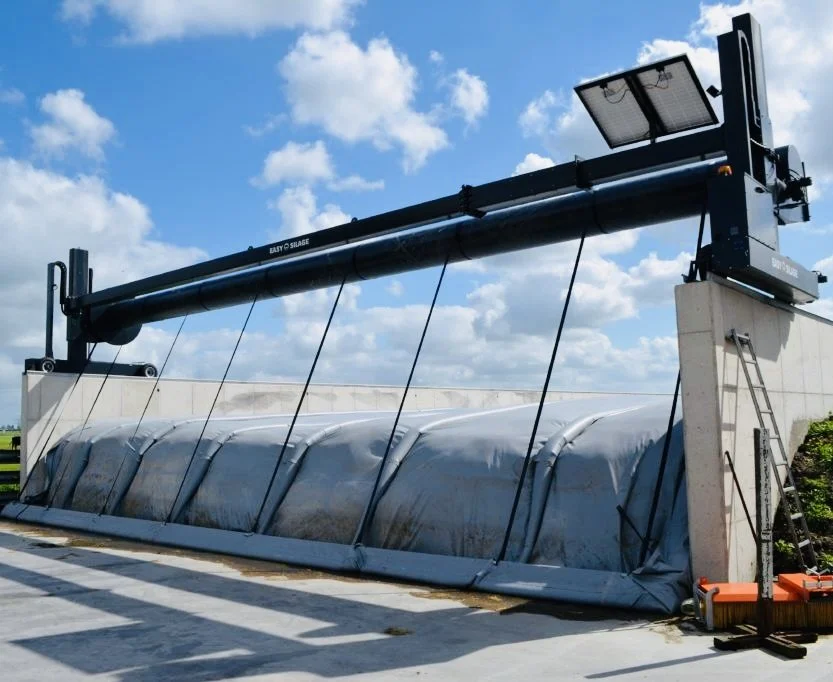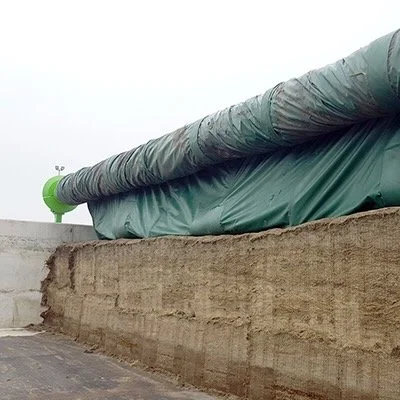Automated silage clamp sheeting - fantasy or future?
Fantasy farming time, or the best idea to come out of the low countries? I’m not sure which it is because the automated hands free silage clamp sheeting systems that several dutch companies (such as Easy Silage - Agridek and Kornet Beton) have developed are not yet to be common place in the parts of the world I have visited. But let's face it, a machine that sheets the whole silage clamp, weighs the covers down and can also do the whole thing in reverse to open up for feeding is a bit more exciting than a pair of wooden Crocs®.
A farmer designed solution
They say necessity is the mother of all invention, but drudgery might be its great aunt because pulling sheets and throwing tyres is not a job that many of us love. And those unpleasant tasks are just as important when it comes to firing the imaginations “there must be a better way than this” department into action.
Gantry system by Agridek
There is more to it than that though, because sheeting silage is one of the more risky operations that we all undertake. It is also an operation that really needs more than one pair of hands; and that’s becoming more of an issue as enthusiastic skilled staff are becoming more and more difficult to find. So faced with all this, it’s no surprise that at least one farmer came up with an automated solution to the problem.
How automated silage sheeting works.
In essence the sheet is unrolled from a massive roller that stretches the entire width of the clamp. The roller and sheet are supported by a frame that either sits in channels fixed to the top of the walls or by a wheeled gantry where a motor (electric or hydraulic) winds and unwinds the sheet. There are some subtleties to the system that make it all work, for a start off it’s not a “standard” sheet.
The cover is designed to be much more robust so it can withstand multiple rolling and unrolling operations. These covers are not designed for manual handling, with a weight of more the 1.5kg per square metre you’re not going to be able move much of it. This helps to ensure that they are not damaged by crows and rodents. In most cases the top layer of the covers are also coated to help reflect solar radiation to try and prevent the silage underneath heating up more than is absolutely necessary. The sheets are also designed to be wider than the internal width of the clamp to allow for overfilling and to make it easier to seal up to the walls in a “half filled” clamp.
The ultimate no tyres silage clamp?
A clamp without tyres, without gravel bags and without heavy mats - how is that going to work?
Well the covers are already very heavy so they already have good contact with the forage surface but to seal the deal and make sure the covers stay in place, the systems have an integrated liquid ballast system - or sausages filled with water in other words! It’s a neat solution but also a slightly terrifying one.
The Easy Silage solution to securing silage sheets
The top layer of the clamp cover has continuous tubes formed on the upper surface. These water tight sausages are filled with water to provide a minimum 100kg per linear metre of compressive force. That is weight without lifting anything, just turn on the tap! But it’s not tap water, or shouldn’t be, because it’s going to need some antifreeze properties so salt water is usually piped into the tubes.
Now however practical and sensible that is, nor however much testing they have done, the first time you turn on the taps on is going to be scary. Would you let hundreds of gallons of water into pockets in the sheet on top of your precious silage? Well maybe it’s just a first time issue because loads of farmers are already doing this.
Easy opening silage clamps
When it comes to opening the clamps, it’s a simple matter of letting some of the water out and rolling up the sheet - all by remote control. And I think that is one of the key advantages; this easy open, easy close solution encourages multiple cuts to be taken. This can be achieved without the usual risks of wastage between layers because the clamp is opened or closed in less than 30 minutes. The lasagna silage option (lots of layers) is much more popular in some countries and this type of silage clamp covering is very much designed for this technique.
When it comes to feed out, opening a bit more silage face is also super easy with these solutions. Let a few litres of water out of the sausages and hold the roll back button on the remote control for a couple of seconds. It’s this sort of solution that ensures you don’t just roll back “a couple of weeks worth of sheet to save us the bother”, but rather expose just what is needed.
So what’s not to like about automatic silage sheeting?
Well it’s a machine, so it will go wrong, and probably when you are already having a bad day. But if that’s put you off then you’re probably still using a three legged stool and milking by hand because the rest of us all rely on machines every day. The technology that these systems use is simple and straightforward so maintenance and repairs shouldn’t be a deal breaker. The cost however just might be and I don’t have any experience about that.
What is a limitation for many, is the physical requirements; most machines work in clamps up to 15-17m wide. Now that is a good size for a clamp in my mind, but it might not fit with your current layout. I guess that unless you are very lucky then the system would really suit clamps that have been designed to allow for automated sheeting.
Some of the systems use a single gantry that has interchangeable rollers, allowing a single gantry unit to cover and uncover multiple clamps. Again this probably suit clamps that have been designed for the system.
Who suits automated silage sheeting?
Whilst the principal is extremely attractive, these solutions seem to really suit some specific farmers. Probably single handed dairy units are those most likely to benefit for an autosheeter. Rolling back silage sheet on your own is no fun, it’s hard work and it’s dangerous too - working at height on a slippery surface littered with trip hazards close to an unprotected edge…..
Automated sheeting also suits those making lots of cuts of silage too because it takes out some of these problems with opening and closing the clamp. It is also no real surprise that it suits farms built on the level too - well it was invented in Holland!
Despite all this, automated silage sheeting might be something that is attractive to you, and something you haven’t seen before? Whatever your opinion if you want to discuss silage covering in more detail or would like to discuss any other aspects covered in this series, contact me at jeremy@silageconsultant.co.uk




